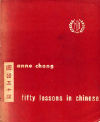Fifty lessons in Chinese
Last updated: 17.12.19

| Printed: | 1956 | Author: | Anne Chang |
| Publisher: | Donald Moore | ISBN: | |
| Suppliers: | 

|
Colloquial grammar and sentence constructions, with a full writing guide, exercises, keys and an alphabetical vocabulary.
Personal remarks:
This is an absolutely splendid little book. One of my first purchases on arriving in Singapore in 1961, it lived in my ditty box for a good number of years before taking up an honoured place on my library shelves. Heavily used with sweaty thumb marks marring the first nine lessons which I worked through as best I could. The layout is a model of succinctness with beautifully calligraphed Chinese characters on the right-hand pages facing the lessons and exercises on the left.
The author, Anne Chang very interestingly wrote in her preface:
This book was written in 1942 and used experimentally during the long days of the Japanese Occupation. I revised it in England in 1953, and again in Singapore early in 1954, partly with the view to publication but primarily for my own pupils.
The principles on which the lessons are based are two: to start from the simplest characters containing the fewest strokes, working up to the more complicated characters; to relate Chines construction (and I am dealing here with Kuo Yü or National Language, commonly known as Mandarin, not literary style or dialects) to Western notions of grammar, so that the English-speaking student who is out to gain only a working knowledge can start off with a point of contact and some measure of grasp. These two principles are so elementary and do so much towards eliminating the initial difficulty in studying Chinese that I am amazed that, so far as I know, no book published in England, America or the Far East has applied both of them.
I only stopped using this book when the enormity of the task in learning "Chinese" dawned on me. (I was at the same time learning Malay, a much easier exercise!). Not only did my hard-won knowledge find no use in the streets of Singapore among the plethora of ill-spoken languages in all manner of tongues but I also found that I was starting to read Chinese characters directly into English without verbalising in Mandarin at all! At least I understood and learned the value of utilising subtitles in Chinese/Mandarin films. That I did not finally achieve literacy in Mandarin is certainly no fault of this tutor par excellence. I well recommend it to others hopeful of fulfilling the task.

